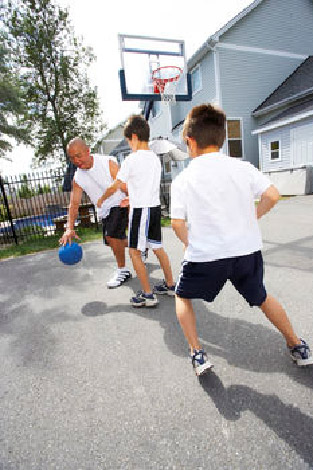Dietary and Exercise Recommendations for Children and Adolescents for Healthy Living
Obesity in children has increased so quickly over the past 30 years that it is now thought of as an epidemic. More than 23 million, or 2 out of 3 children and teenagers are either overweight or obese. And rates continue to rise.
Experts agree that diet and exercise play very important roles in your child’s risk for building up unhealthy weight. The American Academy of Pediatrics suggests the following diet and exercise guidelines for children and adolescents. These guidelines are based on evidence from studies that show that they help improve the health of youth.
Prior to Birth
Age Birth to 23 Months Old
Age 2-3 Years Old
Age 4-8 Years Old
Age 9-13 Years Old
Age 14-18 Years Old
Prior to Birth

- obesity
- diabetes
- heart disease.
So during pregnancy, it is important to:
- get regular prenatal care and screening for diabetes;
- exercise according to doctor recommendations;
- take a daily prenatal vitamin;
- gain a healthy amount of weight – not too much and not too little.
Use the chart below to find out how much weight you should gain based on your pre-pregnancy weight body mass index (BMI).
| Pre-pregnancy BMI |
Recommended total pregnancy weight gain |
|---|---|
|
Underweight: pre-pregnancy BMI less than 19.8 |
28-40 pounds |
|
Normal weight: pre-pregnancy BMI 19.8-26.0 |
25-35 pounds |
|
Overweight: pre-pregnancy BMI 26.0-29.0 |
15-25 pounds |
|
Obese: pre-pregnancy BMI greater than 29.0 |
15 pounds at most |
Institute of Medicine. Nutrition During Pregnancy. Washington DC: National Academy of Sciences; 1990.
Age Birth to 23 Months Old
Fighting obesity must start early. Building up too much baby fat can increase the risk of your child becoming fat later in life.
During the first year of life, the focus should be on the unique nutritional needs of each specific growth period. Your child’s health care provider should closely monitor your child for appropriate growth and weight gain. Introduce family mealtime once your child begins to eat table foods at around 6-9 months of age. Children who eat meals with the family are less likely to be obese.
Exercise should generally be focused on unstructured, safe play environments. Activities that promote free movement and development, such as providing tummy time for an infant, are important at this stage.
Following safe sleeping guidelines is also important during this period of a baby’s life. Risk of SIDS (Sudden Infant Death Syndrome) is highest during the first 12 months after birth. To reduce this risk:
- Place your baby on his back on a firm surface for every sleep.
- Keep soft objects, loose bedding, and toys out of the crib.
- Do not sleep with your baby – or “co-sleep”.
- Breastfeed as much and as long as possible.
- Avoid smokers and cigarette smoke.
Nutrition Recommendations from Birth to 11 Months Old:

If you must use formula, however, follow these guidelines:
- First few weeks: Feed about 2-3 ounces of formula every 3-4 hours.
- After first month: Feed at least 4 ounces of formula every 4 hours.
- After six months: Feed about 6-8 ounces of formula 4-5 times each day.
- When using powdered formula, remember to follow mixing directions on the package. Do not dilute with too much water.
On average, a baby should drink 2.5 ounces of formula for each pound they weigh every day. For example, a 10-pound baby should drink 25 ounces of formula each day.
Start other sources of nutrition:
- rice and pureed baby foods, around 6 months, but no earlier than 4 months.
Introduce healthy foods like:
- vegetables
- fruits
-
protein such as:
- meat
- poultry
- tofu
- egg yolk.
Continue to offer these foods even if your baby initially refuses them.
Wait until your baby is at least 6 months of age before offering 100% juice. Limit juice to no more than 4-6 ounces per day, and offer it only with a meal or snack.
Nutrition Recommendations from 12 to 23 Months Old
When your baby is 12 months old, you may give him or her whole cow’s milk. At that time, limit the amount of milk your bab
Continue to introduce healthy foods like:
- vegetables
- fruits
-
protein such as:
- meat
- poultry
- tofu
- egg yolk.
Offer these foods even if your baby initially refuses them. Do not introduce foods without any nutritional value simply to provide extra calories. Limit salt/sodium intake to less than 1500 mg per day.
Give juice in a cup only – not a bottle. Make eating a social event for the family by establishing regularly scheduled meals together. Do not overfeed or force your child to finish meals if he or she is not hungry.
If you are concerned about your baby becoming obese, discuss this with your baby’s doctor. Do NOT put a baby younger than 2 years old on a diet or restrict their calories and dietary fat intake.
Recommended Overall Dietary Intake for a One Year Old |
|
900 calories each day (no differences between boys and girls)
Must include:
Additional calories should be used as carbohydrates. *For example, one piece of whole grain bread = 1 ounce |
Exercise Recommendations from Birth to 23 Months Old:
Provide a safe, nurturing, minimally structured play environment for your child to participate in daily.
- Organized exercise programs or classes are not necessary.
- Children younger than 2 years old should not watch any TV.
Allow infants/toddlers to explore the outdoors with supervision so they can develop an enjoyment of the outdoors. Activities include:
- walking in the neighborhood
- unorganized free play outdoors
- walking through a park or zoo.
Age 2-3 Years Old
He
You might notice that your toddler’s appetite has dropped. This is usually okay since growth rates have slowed. Your toddler might not need as much food as he or she did as a baby. Parental modeling of appropriate eating behavior is also important at this age during family meal times.
Focus exercise to allow for your child’s continued development and safe exploration outdoors.
Nutrition Recommendations for 2-3 Years Old:
Eat regularly scheduled family meals together, and make them social events for the family. This will promote social interaction and give you a chance to role model positive food-behavior.
- Parents, not children, should choose meal times.
- Avoid forcing children to eat when they are not hungry. This leads to overeating.
-
Limit snacking while:
- watching TV
- playing video games
- playing on the computer.
Provide meals with a variety of choices of fruits and vegetables instead of ice cream, salty snacks, fried foods, and cookies.
- Use fat-free or low-fat dairy products.
-
Encourage 2 servings of fish each week but avoid:
- shark
- swordfish
- king mackerel
- tilefish.
- Limit salt/sodium to less than 1500 mg each day.
Avoid or limit sweet/sweetened beverages such as soda, juice, sports drinks to a maximum of 4-6 ounces each day, if given. Also try to avoid these beverages as snacks.
Recommended Overall Calorie Intake for 2-3 Years Old |
|
1000 calories each day (no differences between boys and girls)
Must include:
Additional calories should be used as carbohydrates. *For example, one piece of whole grain bread = 1 ounce. |
Exercise Recommendations for 2-3 Years Old:
Parents should provide a safe, nurturing, minimally structured play environment for the child to participate in daily.
- Organized exercise programs or classes are not necessary.
- Toddlers should take part in 30 minutes of adult-led physical activity and 60 minutes of free play every day.
-
Limit to 1-2 hours each day:
- TV
- video games
- computer times
Children younger than 2 years old should not watch any TV.
Toddlers should be allowed to explore the outdoors with supervision to help them develop an enjoyment for the outdoors. Activities include:
- walking in the neighborhood
- unorganized free play outdoors
- walking through a park or zoo.
Age 4-8 Years Old
During young school ages, family meal times continue to be important, especially with regard to parental modeling. Additionally, following through with reduced snacking and healthy food choices remain key ways to encourage proper nutrition.
Organized play and participation in simple sports or dance activities become new ways to incorporate exercise. If it is not possible for our child to be in organized activities, consistent organized play should be enforced so that your child begins to learn the habit of regular exercise. Free play each day is also important, however, and should be added into your child’s daily schedule.
Nutrition Recommendations for 4-8 Years Old:
Eat regularly scheduled family meals together, and make them social events for the family. This will promote 
- Parents, not children, should choose meal times.
- Avoid forcing children to eat when they are not hungry. This can lead to overeating.
-
Limit snacking during:
- watching TV
- playing video games
- playing on the computer.
Continue to offer a variety of healthy foods even if your child is a picky eater.
- Provide meals with a variety of choices of fruits and vegetables instead of ice cream, salty snacks, fried foods, and cookies. Use fat-free or low-fat dairy products.
-
Encourage 2 servings of fish per week but avoid:
- shark
- swordfish
- king mackerel
- tilefish.
- Limit salt/sodium to less than 1900 mg per day.
Avoid or limit sweet/sweetened beverages such as soda, juice, sports drinks to a maximum of:
- 4-6 ounces per day for children 4-6 years old
- 8-12 ounces per day for children 7-18 years old.
Also try to avoid these beverages as snacks.
Recommended Overall Calorie Intake for 4-8 Years Old |
|
| 1400 calories each day for boys | 1200 calories each day for girls |
Must include:
Additional calories should be used as carbohydrates. |
Must include:
Additional calories should be used as carbohydrates. |
Exercise Recommendations for 4-6 Years Old:
Encourage at least 60 minutes per day of free play with an emphasis on:
- fun
- playfulness
- exploration
- experimentation.
Co-ed activities that include both girls and boys are suitable, since there is little difference between the sexes in weight, height, endurance, and motor skills. Appropriate activities include:
- throwing/catching
- running
- swimming
- tumbling.
Ensure proper safety and adult supervision.
Encourage your child to participate in 30 minutes of adult-led activity per day. Expect a pre-school aged child to walk reasonable distances with family members.
Limit to less than 2 hours per day:
- TV
- video games
- computer times
Exercise Recommendations for 6-8 Years Old:

-
vigorous-intensity aerobic activity at least 3 times per week such as:
- running
- jumping rope
- bicycle riding.
-
Muscle-strengthening physical activity at least 3 times per week such as:
- push-ups
- tree climbing
- sit-ups.
- Bone-strengthening physical activity at least 3 times per week such as:
- hopping
- jumping rope
- running.
Co-ed activities that include both girls and boys are suitable since there is little difference between the sexes in weight, height, endurance, and motor skills.
Competitive organized sports – such as soccer, baseball – may be introduced at this time but with the following conditions:
- flexible rules
- short instruction time
- free time within practices
- focus on enjoyment rather than competition
- limited team strategy instruction.
Encourage free play that involves learning new physical skills with proper safety and adult supervision. TV time should be limited to 2 hours or less per day. Encourage:
- walking
- dancing
- jumping rope
- miniature golf.
Age 9-13 Years Old
With the onset of puberty during middle school years, nutritional requirements start to differ between boys and girls. Your job as a parent is to monitor what your child eats; your child’s job is to determine how much to eat. Having healthy snacks and meals available at home when your child is hungry will help them learn how to make healthy choices. Having them assist with the shopping and preparation of meals and snacks is another way to encourage good decisions about foods.
Options of regular exercise include involvement in more complex sports as well as supervised weight/strength training. An emphasis on enjoyment of regular exercise is important at this age.
Nutrition Recommendations for 9-13 Years Old:
Eat regularly scheduled family meals together, and make them social events for the family. This will promote social interaction and give you a chance to role model positive food-behavior.
- Encourage daily breakfast and one afternoon snack each day.
- Avoid forcing children to eat when they are not hungry as this leads to overeating.
Provide meals with a variety of choices of fruits and vegetables instead of ice cream, salty snacks, fried foods, and cookies.
-
Encourage 2 servings of fish each week but avoid:
- shark
- swordfish
- king mackerel
- tilefish.
- Use fat-free or low-fat dairy products at home.
- Limit salt/sodium to less than 2200 mg each day.
Avoid or limit sweet/sweetened beverages such as soda, juice, sports drinks to a maximum of 8-12 ounces each day.
Recommended Overall Calorie Intake for 9-13 Years Old: |
|
|---|---|
|
1800 calories each day for boys |
1600 calories each day for girls |
Must include:
Additional calories should be used as carbohydrates. *For example, one piece of whole grain bread = 1 ounce. |
Must include:
Additional calories should be used as carbohydrates. *For example, one piece of whole grain bread = 1 ounce. |
|
|
|
Exercise Recommendations for 9-13 Years Old:
Encourage activities that focus on physical skill development and understanding of sports tactics. These activities should occur a minimum of 60 minutes every day, 7 days each week.
- Emphasize enjoyment with family members and with friends.
-
Activities can include the following complex sports:
- football
- basketball
- ice hockey
- volleyball
-
individual sports
- tennis
- track & field
- running
- swimming
- dance.
-
Physical activity should occur every day for 60 minutes and should include:
-
vigorous-intensity aerobic activity at least 3 times per week:
- running
- dancing
- swimming
- bicycle riding.
-
muscle-strengthening physical activity at least 3 times per week:
- push-ups
- use of resistance bands
- sit-up
- Weight training may be started as long as good supervision and teaching of proper techniques are provided. Your child should use small free weights of 15-20 pounds with high repetitions.
-
bone-strengthening physical activity at least 3 times per week:
- basketball
- tennis
- running.
-
vigorous-intensity aerobic activity at least 3 times per week:
Age 14-18 Years Old
Nutritional requirements differ between boys and girls during adolescence due to pubert
Exercising options are similar to that of adults except for caution regarding heavy weight training in those adolescents who have not completed their growth.
Nutrition Recommendations for 14-18 Years Old:
Eat regularly scheduled family meals together, and make them social events for the family. This will promote social interaction and give you a chance to role model positive food-behavior.
- Encourage daily breakfast and one afternoon snack each day.
- Avoid forcing children to eat when they are not hungry as this leads to overeating.
Provide meals with a variety of choices of fruits and vegetables instead of ice cream, salty snacks, fried foods, and cookies.
- Use fat-free or low-fat dairy products at home.
-
Encourage 2 servings of fish per week but avoid:
- shark
- swordfish
- king mackerel
- tilefish.
- Limit salt/sodium intake to less than 2200 mg each day.
Avoid or limit intake of sweet/sweetened beverages such as soda, juice, sports drinks to a maximum of 8-12 ounces each day.
Recommended Overall Calorie Intake for 14-18 Years Old |
|
|---|---|
| 2200 calories each day for boys | 1800 calories each day for girls |
Must include:
Additional calories should be used as carbohydrates.
*For example, one piece of whole grain bread = 1 ounce. |
Must include:
Additional calories should be used as carbohydrates.
*For example, one piece of whole grain bread = 1 ounce |
Exercise Recommendations for 14-18 Years Old:
Encourage activities that focus on your teen’s individual idea of fun and on his/her enjoyment with friends. Activities should occur a minimum of 60 minutes every day, 7 days each week and can include the following:
- yoga
- dance
- running
- walking
- cycling
- household chores
- competitive or noncompetitive sports.
Aerobic activity should occur daily, including vigorous-intensity activities such as:
- running
- bicycle riding
- sports such as soccer or swimming at least 3 times each week.
Weight training:
- If your teen has completed puberty – at least 3 times each week without restrictions
-
If your teen has not completed puberty – Weight training may be initiated provided good supervision and teaching of proper techniques using small free weights (15-20 pounds) with high repetitions.
- In children who have not completed puberty, avoid using heavy weights with short sets and avoid squat lift weights exercises.
Points to Remember:
|
References
American Academy of Pediatrics: healthychildren.org. Accessed: http://www.healthychildren.org/English/agesstages/gradeschool/nutrition/pages/Cooking-With-Your-Children.aspx
American Heart Association. Gidding et al. 2006 Dietary Recommendations for Children and Adolescents: A Guide for Practitioners. Pediatrics. Feb; 117(2): 544-559. Accessed: http://pediatrics.aappublications.org/content/117/2/544.full.pdf+html?sid=3bbf2e40-be42-4056-b18c-d70e7e089ebb
Barker DJP, Osmond C. 1986 Infant mortality, childhood nutrition, and ischemic heart disease in England and Wales. Lancet: 1: 1077-1081.
Dyer JS, Rosenfeld CR, Rice J, Rice M, Hardin DS. 2007 Insulin resistance in Hispanic Large For Gestational Age neonates at birth. J Clin Endocrinol Metab. Oct; 92 (10): 3836-3843.
Eriksson JG, Forsen TJ, Osmond C, Barker DJ. 2003 Pathways of infant and childhood growth that lead to type 2 diabetes. Diabetes Care 26 (11): 3006-3010.
Institute of Medicine. Nutrition During Pregnancy. Washington DC: National Academy of Sciences; 1990.
National Center for Health Statistics. Health, United States, 2006. www.cdc.gov/nchs/hus.htm; accessed December 2007.
The American Academy of Pediatrics Policy Statements.
US Department of Agriculture & US Department of Health and Human Services. 2010 Dietary Guidelines for Americans. Accessed: http://www.cnpp.usda.gov/Publications/DietaryGuidelines/2010/PolicyDoc/PolicyDoc.pdf
US Department of Health and Human Services. 2008 Physical Activity Guidelines for Americans: Chapter 3: Active Children and Adolescents. Accessed: http://www.health.gov/paguidelines/guidelines/chapter3.aspx
This article was originally written by Dr. Jennifer Dyer, MD.
Ashley Lucas, PhD, Dietetic Intern, The Ohio State University, assisted in the current review of this content.
For more information:
Go to the Obesity and Weight Management health topic.






